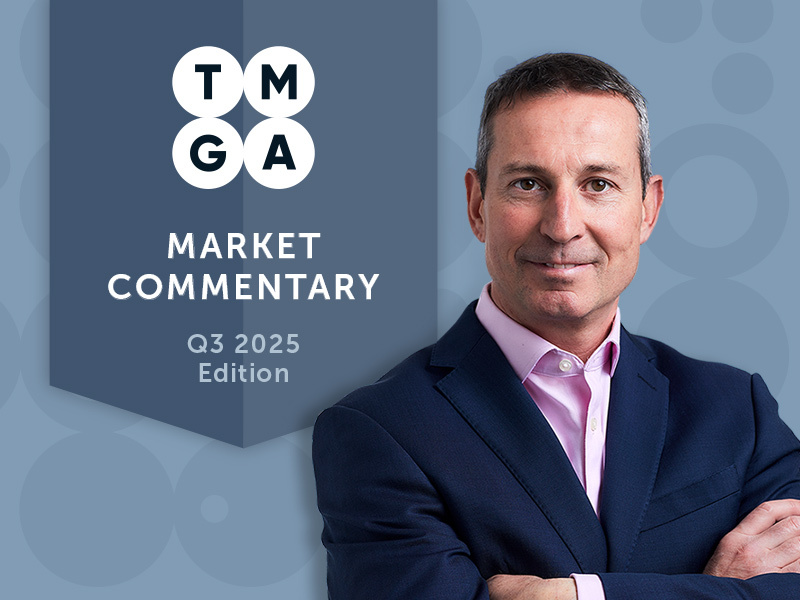

Trump continues to use tariffs as a strategic economic tool to rebalance trade deficits and bolster US industry, with China remaining a key focus. Despite scepticism surrounding various ‘thin’ trade deals, equity markets responded positively – particularly after Trump’s emphatic proclamation that the “deal with China is done”.
Meanwhile, Europe continued to advance its fiscal and defence plans. At the latest NATO summit, defence spending commitments increased to 5% of GDP by 2035. Germany unveiled €46 billion in corporate tax relief and plans to relax debt constraints, opening the door for significant infrastructure and defence investments. The broader EU have already committed to up to €800 billion in national spending, including €150 billion earmarked for defence loans.
These aggressive policy shifts have reshaped equity market leadership. European equities have outperformed in 2025, benefiting from this robust fiscal stimulus and continued monetary easing. The ECB delivered its eighth consecutive rate cut, with inflation moderating across Europe. In contrast, US equities, while rebounding, are hampered by comparatively tighter Federal Reserve policy. Recent Fed minutes reflect a cautious tone, emphasising inflation persistence and slowing growth, frustrating Trump, whose public clashes with Fed chairman Powell continue unnerving markets.
Recent Fed minutes emphasise inflation persistence and slowing growth.
In the UK, Starmer secured a trade deal with the US given the UK’s modest trade surplus. This builds on the landmark trade agreement with India – the UK’s largest since Brexit which is expected to yield greater economic benefits than earlier deals with Australia, Japan and New Zealand combined. Unlike the Fed, the Bank of England appears set to continue cutting rates. Despite setbacks for Labour, stability in government, rising M&A activity, foreign investor interest and record share buybacks underpin the FTSE 100 rally.
Emerging Market dynamics continue to shift. Investors continue to rotate away from India toward China, buoyed by improved sentiment following China’s trade deal with the US. Nevertheless, China’s cooling property market which is critical to household wealth remains a drag on consumer activity. Technological advancements remain a bright spot, particularly after the Q1 excitement surrounding Deep Seek and its low-cost AI language model. A recent Australian Strategic Policy Institute study highlights China’s leadership in 57 of 64 critical technologies from 2019-2023, with India rapidly ascending to Top 5 rankings across 45.
Investors continue to rotate away from India toward China.
Emerging Markets benefit from a weaker US dollar. Whilst US dollar uncertainties persist; we continue to maintain material Sterling hedging against US investments across strategies.
In the US, some of the “Magnificent Seven” mega-cap tech stocks remain vulnerable to corrections after a strong rally post-Liberation Day. However, their recent earnings continued to outpace the broader market. Medium-cap stocks, recently shaken by recessionary concerns, are more attractively priced. While soft landing odds remain intact, recession fears have resurged.
Healthcare underperformed following Trump’s election, marking the third significant retreat in four decades. Historically, such periods have offered strategic entry points, especially with a pipeline of innovative pharmaceutical and medical device launches anticipated.
Gold hedges uncertainty, driven by Central Bank buying.
Fixed income markets remain volatile, though yields are appealing amid easing inflation and relatively stable central bank policies. Gold continues to serve as a hedge against geopolitical and financial uncertainty, bolstered by Central Banks buying. Although global gold reserves have returned to Bretton Woods era levels (mid 1940s to early 1970s), they now comprise just 17% of global supply well below 60% during that era.
Following the sharp rally from April lows, US equities may face short-term headwinds. Still, markets have absorbed shocks including conflict in Iran with relative resilience. Meanwhile, valuations across Europe, the UK and Emerging Markets remain more compelling. Continued fiscal and monetary momentum, especially in Europe, should support broader equity returns going forward.




